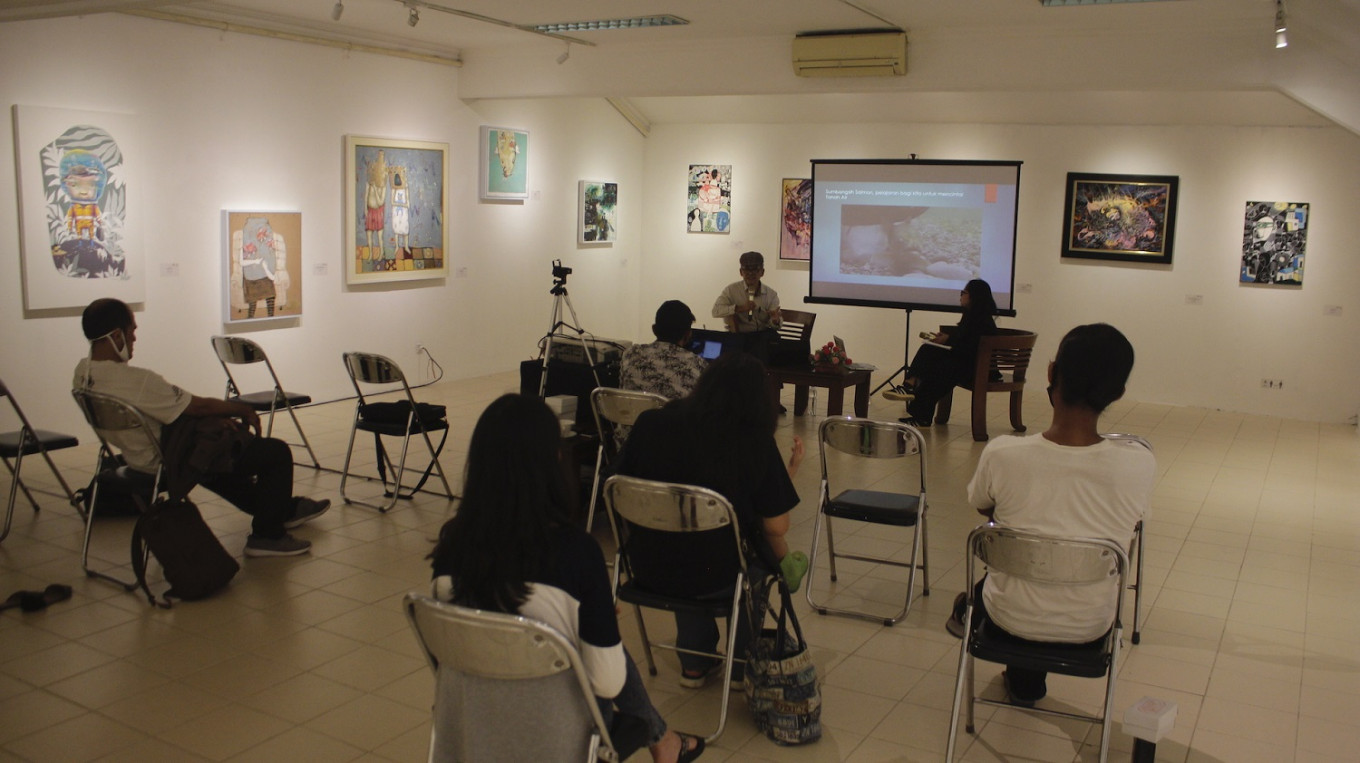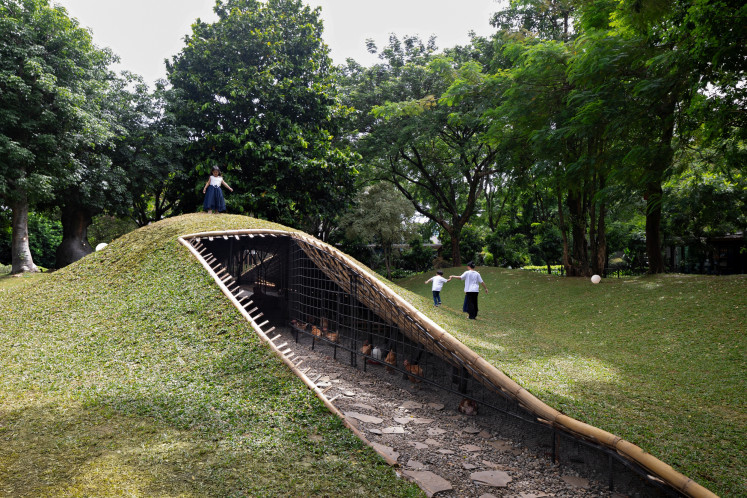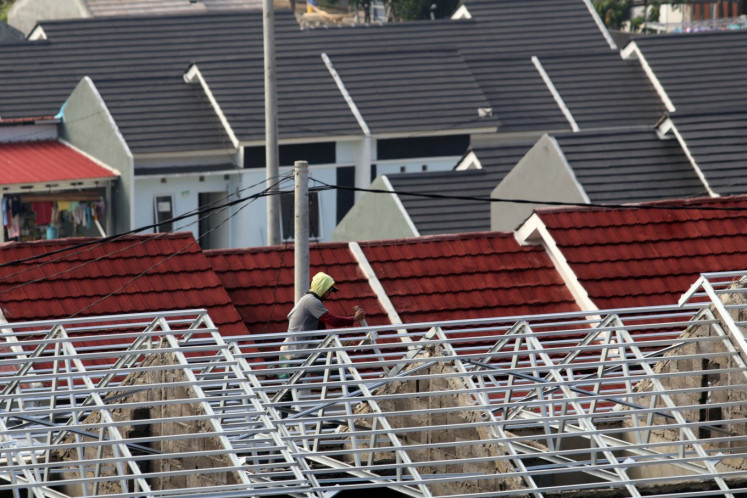Popular Reads
Top Results
Can't find what you're looking for?
View all search resultsPopular Reads
Top Results
Can't find what you're looking for?
View all search resultsNew innovations adopted during pandemic to help expand Indonesian art market
While physical art events were restricted due to government coronavirus regulations, online innovations have enabled the art world to interact - with a myriad of new and positive outcomes.
Change text size
Gift Premium Articles
to Anyone
T
he digital realm during the 2020 pandemic has proved to be the art world’s savior. While physical art events were restricted due to government coronavirus regulations, online innovations have enabled the art world to interact - with a myriad of new and positive outcomes.
A panel discussion in Yogyakarta on Oct. 29 via Zoom focused on how to overcome the problems encountered in the regional art world during the pandemic. The discussion was part of the Mayinart-Indonesia Showcase "Ataraxia" organized by Mayinart, a Singapore-based platform that targets an international market for affordable art.
Moderated by respected Indonesian curator Ignatia Nilu and themed "Art & Its Industry Post COVID…….What Comes Next?", the panel featured Dwi Marianto, art critic and senior lecturer at the School of Fine Arts of the Indonesian Arts Institute (ISI) Yogyakarta, and art collector Donald Tan in Singapore along with two of the most brilliant minds in the Indonesian art world. Aan Andonowati, founder of ArtSociates and Lawangwangi Creative Space, was located in West Java's Bandung while Soemantri Widagdo, chairman of the advisory board of TiTian Bali Foundation, was in Ubud.
The discussion began with Dwi giving an introduction to the topic and sharing about how the pandemic had impacted art making practices in Yogyakarta. He stated that innovations in technology would be crucial in both artmaking and new business models. Tan gave an overview of how the pandemic had impacted the Singapore art world. He noted that there had been a slump in the market; although collectors are still buying, but more so in a supportive manner.
Of most interest were the comments from Aan and Soemantri. Aan described her recent projects and innovations geared to expanding the art market and promoting the Indonesian creative industry during this phenomenal new cycle of change. She is coordinating her latest three-part project "COLABOREA" that has been organized in response to the pandemic.
Peer-to-peer
The COLABOREA brand has established three new peer-to-peer (P2P) projects linking different industries within a single platform: art and design; working and living; and food and culture. In art COLABOREA functions as a facilitator, allowing the stakeholders (artists, creatives and end users) to collaborate directly with each other. It specializes in affordable art and art-based designed objects according to the needs of the clients, producing limited edition artist-series objects from Indonesian artists. The Lawangwangi building complex is an ideal base for these activities as it incorporates both technical and digital labs, along with programs including workshops, talks, residency programs and art management.
The COLABOREA project uses a P2P model that is not centralized, removes the middleman and therefore does not restrict the flow of information between the different stakeholders. Through this project Aan perceives that art initiatives are moving toward a situation where the artists are instrumental as ‘start-ups’ and the collectors participate as shareholders. The artists and creatives as well as the customers/buyers/collectors are the beneficiaries. This model opens the art and creative sphere to new possibilities of seamless collaborations along with the associated economic benefits.
Soemantri began by describing the first significant digital disruption in the art market. The development of eBay, the world’s first e-commerce marketplace, in 1995 created a platform that directly connects art buyers with the artists. This began the erosion of the conventional artist-to-gallery-to-buyer linear system, thus enabling the bypassing of the "middleman". Both Aan and Soemantri stated that the pandemic had accelerated art world disruption by breaking down the centralized systems.
Pay as you wish
Soemantri then described the ‘pay as you wish’ (PAYW) payment system introduced for online exhibitions of Balinese art through TiTian’s social media platforms. This is an experimental financial model that is being utilized in various ventures around the world. Though initially geared toward achieving sustainability and for providing an income for artists during the economic downturn, the PAYW model appears to alter the traditional assessment of an artwork’s worth to the buyer, and instead generates a more complex evaluation that takes into account an increased set of values. This addition of social and goodwill values appears to be giving a greater equitable personal worth to the buyer/collector.
Aan noted that 'pay as you wish' could evolve when large networks of buyers can be reached and thus the price is stabilized, which perhaps can then be materialized through integration with new technologies such as the blockchain system of tracking transactions.
Continuing on, Soemantri stated that the art world would thrive within the sharing/communal system where expertise and facilities are shared and easily accessible to artists. This concept is being explored by Aan's initiative, COLABOREA working & living.
This growing use of peer-to-peer models has facilitated effective direct communication between makers and buyers, and has increased sales in the marketplace, although there still appears to be a need for a platform hub to unite all the different initiatives. This appears to be coming from online sources as it allows for a greater flow of communication, data, sales and updates.
“I found the discussion very enlightening. During the lockdown, the art world has relied on conventional technology in the viewing of art and the format of the business model,” said moderator Nilu. “We need to go beyond this if we are going to achieve sustainability. I hope this discussion helps trigger people to think outside of the box in pursuit of new ideas.”
The art world has come under criticism over the years for failing to think outside of the box. New business models have not evolved and the marketing machines seem to have placed too much emphasis on "the next big thing" or branding revisits. It seems that the bigger players of the art world have been lagging behind in the innovation stakes. There are new generations of talent waiting to be discovered; creativity is thriving and is found on the streets, online, or in ‘outsider’ venues/events. When the art world’s proverbial box finally unlocks, it might find new horizons of a different world awaiting it.
The Mayinart discussion is a landmark for the Indonesian art world during troubled times. Distinct and relevant, the discussion functioned as a feedback loop by highlighting the exploration of alternatives that can lead to the expansion of the affordable art market through new initiatives and financial models. The necessary chain of events to accelerate the revitalization of the art world follows the system of an idea, innovation, experimentation, results, presentation, feedback and then collaboration.
The Mayinart-Indonesia Showcase included a group exhibition by Indonesian artists at the Jogja Gallery from Oct. 28 to Nov. 7. Some of the exhibiting artists were Nasirun, Sri Pramono, Irwanto Lentho, Januri, AT Sitompul, Irwan Sukendra, Sriyadi Srinthil and Fery Eka Chandra. (wng)











